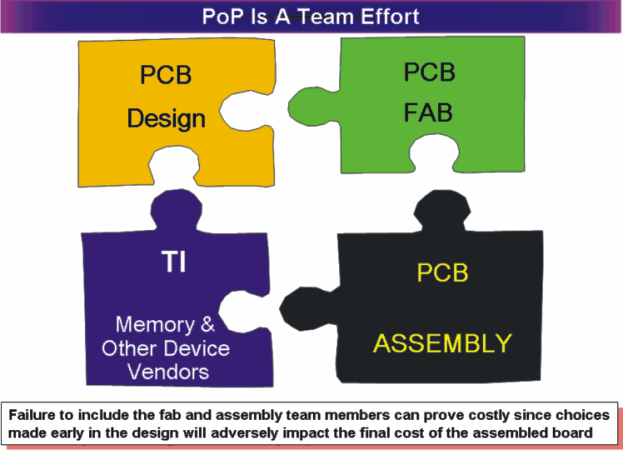SPRAAV1C May 2009 – March 2020 AM3703 , AM3715 , OMAP3503 , OMAP3515 , OMAP3525 , OMAP3530
-
PCB Design Guidelines for 0.4mm Package-On-Package (PoP) Packages, Part I
- Trademarks
- 1 Using This Guide
- 2 A Word of Caution
- 3 A Team Sport
- 4 Be Wary of Quotes
- 5 Don’t Forget Your CAD Tools
- 6 Metric Vs English
- 7 PCB Fab Limits
- 8 Routing and Layer Stackup
- 9 OMAP35x 0.4mm Pitch
- 10 Pad Type
- 11 PCB Pad Dimensions for 0.4mm BGA Package
- 12 Multiple BGA Packages
- 13 Etch Traps and Heat Sinks
- 14 Vias and VIP
- 15 Laser Blind Vias
- 16 Filled Vias
- 17 Know Your Tools
- 18 BeagleBoard
- 19 BeagleBoard Views
- 20 OMAP35x Decoupling
- 21 PCB Finishes for High Density Interconnect (HDI)
- 22 Real World Second Opinion
- 23 Acknowledgments
- 24 References
- Revision History
3 A Team Sport
Successful design and assembly of complex, fine-pitch circuit boards is a Team Sport. The days of tossing circuit diagrams over the cubical wall to the board designer who then tosses them to the assembly shop are gone. Today’s board design requires a team approach and the entire process, from component selection to assembly requires careful coordination.
The typical team is composed of four different members representing the four major steps in product fabrication: the device supplier (chips, passives, mechanical), the PCB designer, the PCB fabrication shop, and the PCB assembly shop. There may be more members or some members may do more than one job.
Each of the team members brings their own experiences and design guidelines to bear on the task. As a result, it is not uncommon to find conflicting guidelines. These conflicts must be resolved prior to the start of work. Unresolved conflicts will result in poor assembly yields at best or 100% failure at worst. Constant and frequent communication is the key to resolving conflicts and everyone must be in the loop.
Get to know your team members and be sure to have frequent meetings as the project proceeds from design through production. It will be money and time well spent.
 Figure 4. PoP Assembly Teamwork
Figure 4. PoP Assembly Teamwork